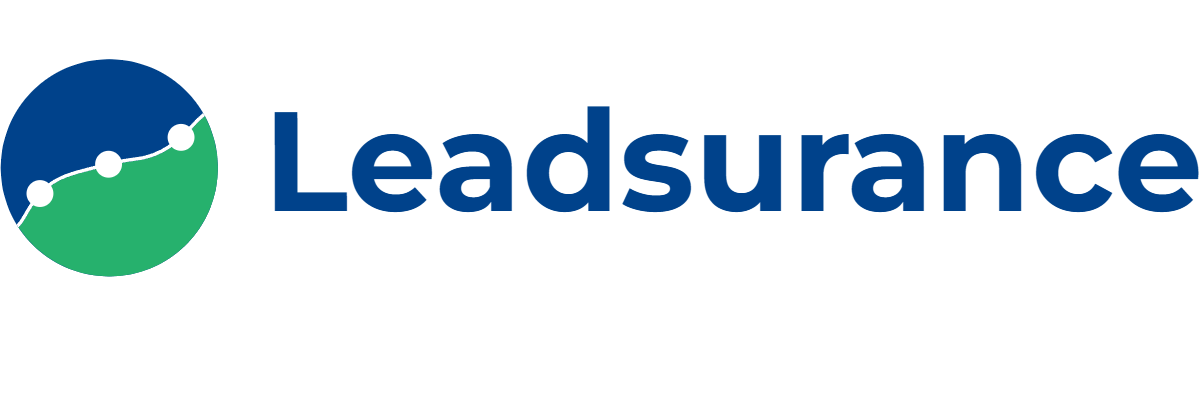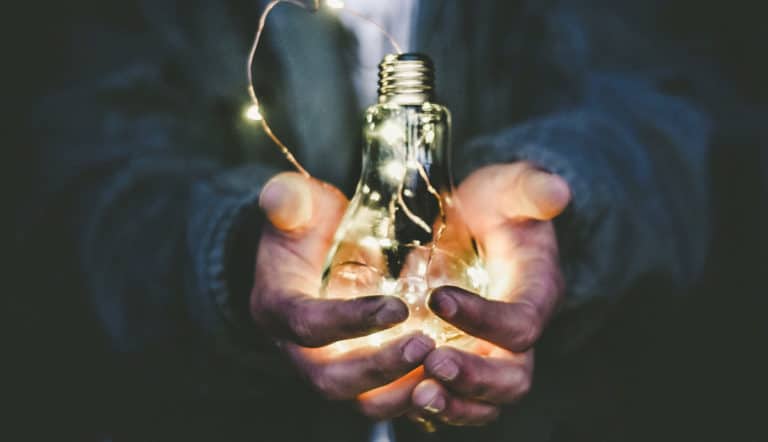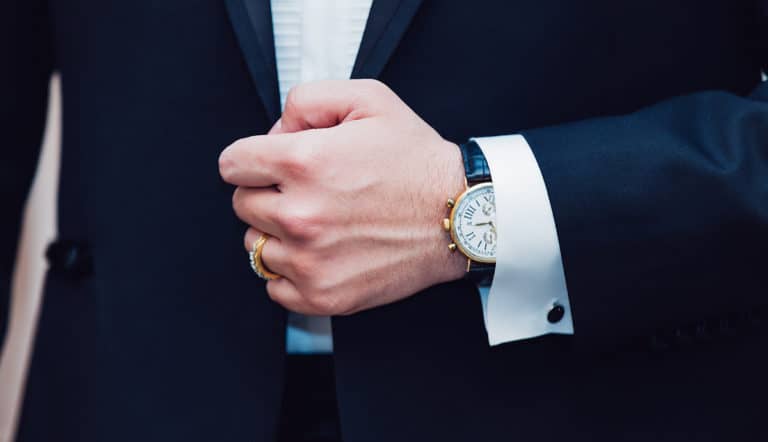When it comes to content marketing and sales in the insurance industry, leads are one of the top priorities, and one of the most expensive assets to acquire.
But, what if I told you there is a way to:
- offer tremendous value
- educate your potential customers
- position yourself as a leader
- and have your visitors convert to a lead
… all in one strategy?
That would be pretty awesome, right?
A key component missing to gaining more leads as you grow your insurance agency is often educational insurance content marketing also known as customer education or policyholder education.
Insurance content marketing through policyholder education is the ongoing process of teaching policyholders how they benefit from various insurance coverage and why they need insurance products.
This marketing tactic works through providing digital content and online courses that you can offer to your customers to increase renewals and the number of additional policies they purchase with you. You can also provide courses for free to prospects who have 0 policies with you to gain more leads and win your clients’ trust.
Educational content marketing is now more than ever, essential for your marketing efforts.
In this article, I want to explain why as well as some ways you can implement this type of content marketing strategy for your insurance agency.
What is Educational Insurance Content Marketing?
Educational insurance content marketing, or policyholder education, is any organized teaching activity carried out through content that targets an audience.
Educating customers provides customers answers to most, if not all, questions they might have about your services, products and the industry.
- How your services/products can help with their challenges?
- How insurance coverage protects policyholders.
- How to use those products?
- How to file claims as a policyholder.
- How to become more aware of opportunities?
- How to compare different levels of coverage.
- Questions or information about the insurance industry, both for new and experienced users.
- General and frequently asked questions that policyholders should understand.
At every stage of education, people need to get real value from you. That means that your prospects need to trust your content and feel confident they have something to gain from it.
The Secret Sauce of Policyholder Education
In the educational phase, your learners have to see how your services can change their businesses, lives, and relationships.
By providing lots of upfront value, you gradually build the expectancy of something that must change their lives.
Then, you can use educational content as a product for upsells, cross-sales, or as free products, you frame yourself as an authority (and get leads).
But make sure that you first try to build rapport and educate and then try to sell (either the online courses or service of yours).
Real Examples of Educating Policyholders
Here are some examples of online learning academies and other types of educational insurance content marketing for policyholders. We have even included a few examples of educational content for financial services.
You can use these to get inspired to create your own online academy or insurance content marketing campaign.

Screenshot from Policy Genius
PolicyGenius creates content that helps people understand insurance, how it can help them, and why they should absolutely have certain types of coverage.
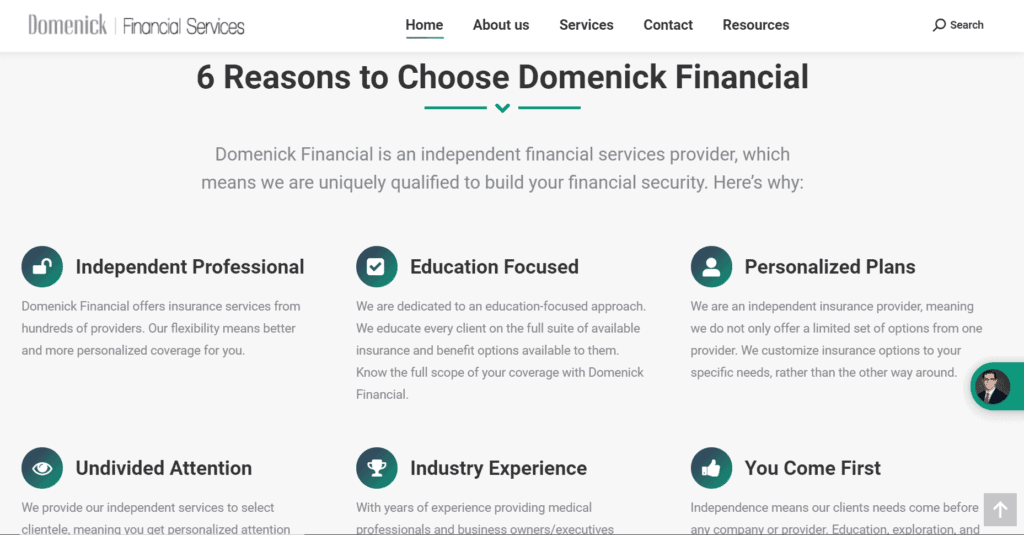
This screenshot is from Domenick Financial one of our favorite clients in Philly, Hey Matthew 👋.
When Matthew first came to us he told us that his brand was education-focused and that he approached each client with a consultative approach to helping them uncover the best coverage for their needs. He was looking to create a content strategy that focused on educating his clients and website visitors on his services and how various types of insurance coverage could benefit them. As big believers in insurance content marketing, we immediately knew we were going to have a long term partnership with Matthew and Domenick Financial because he understood the value of insurance content marketing and educating his policyholders.
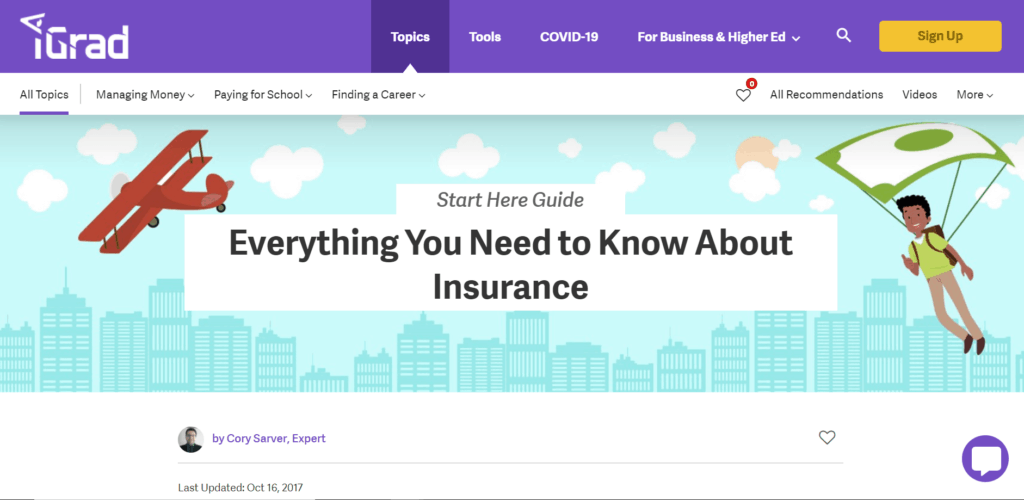
Screenshot from iGrad
iGrad educates consumers and policyholders on the many different areas of insurance so that they can better understand policies, coverage, and claims.
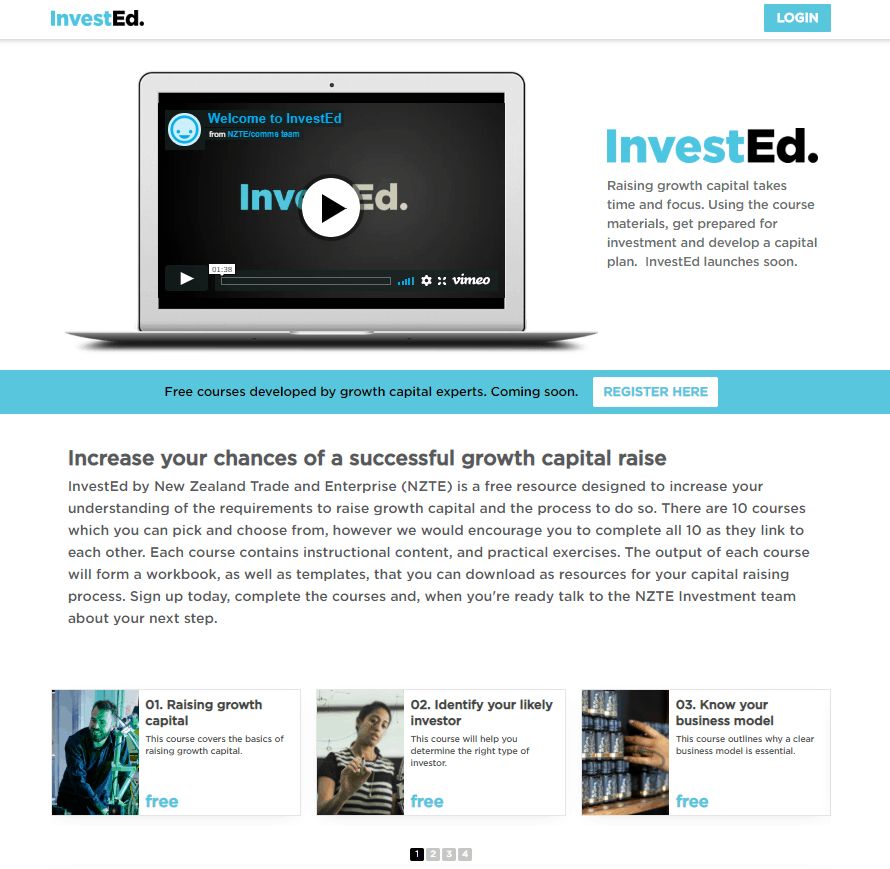
Screenshot from InvestEd Academy
InvestEd offers ten courses that help learners raise growth capital. They include courses like: “Identify your likely investor”, “Know your business model”, “Financial fundamentals”, and others.

Screenshot from Tradeline Specialist Academy
Tradeline Specialist Academy offers a series of courses about credit and tradelines. They offer courses like: “How To Start A Credit Builder Tradeline Business”.
Six Reasons to Build a Policyholder Education Program for Your Website
Educating leads and policyholders can position yourself as a market leader.
More benefits come with customer education. Let’s dive into what else you can reap by applying this strategy:
More Leads
You can offer online courses for free in the exchange of contact information – through lead capture forms from visitors, who give out their email address to join your email list.
You can distribute sign up buttons through your blog, your social media accounts, or your website to generate more leads and followers.
Tip: To minimize the number of spam or misspelled emails that you’re capturing, you could use an email verifier.
More upsells with paid courses
When beginning to offer a service, you can urge customers to join a paid course to learn more about a specific subject that interests them or more case studies that present situations that are similar to what they are going through.
Customers are more likely to buy a paid course, once they have experienced the value of learning and growing with you. So, use this fact at your advantage.
Loyal customers
A loyal consumer is the one who intends to stay within your business’ services and is committed to improving their relationship with you.
The more people trust you the less they don’t mind being sold to. Or if they are already customers of yours, they are more likely to upgrade to higher plans in your services.
Engaged and satisfied customers
When you achieve to inform people as best as possible, the chances are that you will keep customers satisfied longer and create a life cycle of people coming back to you.
An educational program that transforms your customers into experts into your products or services enables potential customers to feel more engaged with your service.
When customers become more able to understand and take full advantage of your services, complaints and customer churn tend to decrease.
Word of mouth recommendations
When people find answers for their problems in your content, this helps you gain the trust of your audience and gain even more leads.
The trust you earn by educating customers makes selling much easier, and your clients are far more likely to become repeat customers.
Also, they then bring your content into the eye-line of new prospects with word-of-mouth recommendations.
Higher quality of customer experience
Quality customer experience lies in two factors: Better customer support and more experienced clients.
If your services include a support team, they will be more able to split their time equally between each of your customers, once your clients will learn most things through your online courses.
Also, your educational efforts play an essential role in transforming simple users of your services to expert users of your services.
How to Incorporate Policyholder Education in Your Website
If you own an insurance agency – you know that your #1 inbound lead channel is your insurance website.
Then the right place to start is your website itself. On your website, you can simply publish educational insurance content that answers your prospects and policyholder’s most common questions about your products and services.
Here are a few different types of content you can start publishing:
- Insurance marketing videos – Videos are a great way to connect with your audience, showcase your expertise, build trust and convert leads.
- Blog Content – Researching blog topics and writing articles is a great way to build up your authority website traffic, and inbound lead pipeline. There is a reason the best insurance blogs publish content regularly.
- Graphics and Social Media Posts – Images, infographics, and social media posts are a great way to share statistics and other informational and educational content in bite-sized pieces. You can integrate your social media content onto your website as well. You can also track your social media analytics to see how your content performs and to get ideas for new topics. Check out our guide to social media for insurance agencies.
- Email Marketing – Make sure you are collecting email subscribers on your insurance website and sending out monthly newsletters to keep them updated. You can also keep your current policyholders on your email list and share useful information with them as well. This is a great way to get existing clients to buy more policies with you. For example, educating homeowners on ways to save when they bundle auto insurance is a way you can get more business from existing policyholders.
And remember, your content can be personal. For example, it is perfectly fine to be funny sometimes and include things like funny insurance memes within your educational content.
Building an Online Academy
Another way to do insurance content marketing is to create online courses for your policyholders and prospects. You can create an entire academy of courses for them to go through.
There are several ways to build an online academy, and you have to choose what works for you. The best way is to find a Learning Management system (LMS) to create, host and provide online courses through your own website.
An LMS allows you to create high-quality courses, host them in a friendly environment and manage both sales & enrollments while providing learning analytics and connections to your other marketing tools.
Alternatively, if you have a WordPress website you can look for an LMS plugin, those are usually of less quality than actual cloud-based LMS, but cheaper.
The third way is a video-academy on YouTube or a blog post series on your website. That might require less technical work, but you are losing some control over the learning flow.
- Easy authoring, that is the ability to create an online course easily.
- User-friendly, that means the platform must be intuitive and user-friendly, customizable, and have a clear structure.
- Customization & branding, how much can you white-label.
- Student management & reporting, it’s your learning CRM. How well you manage and report on your users is extremely important.
- Ecommerce capabilities, being able to sell the training or potential leads can self-enroll. Some “traditional LMS” do not provide this.
- Technically scalable means the platform must be functional and reliable.
- Interoperability & API/SSO that means the platform must support several integrations with other customer-facing systems. If you can’t connect it directly to your CRM, it might connect through Zapier.
Types of Educational Material
Thinking of what you might need to make this possible might be closer at hand. Looking around at your already existing material, you may already have what it takes.
Educational content might be:
- Blog-posts, ebooks, and podcasts
- Case studies of people who solved a problem with your services
- Webinars and video tutorials
- Group or personal meetings (recordings)
- Presentations
Creating the content
After collecting all the content you have in hand, you will need to plan your educational program and decide what additional material you need to create.
For example, you can incorporate comparative details about your services in contrast to your competitors’. This way, learners get better knowledge about similar companies’ average performance and improve their trust in you.
So how do you get learning content on a course platform?
Here are the steps:
- Create a course outline:
Divide the course curriculum into main topics and sub-topics. Set the course sections apart by the level of difficulty, set specific learning goals and strategies.
It might help to brainstorm ideas on how to teach the subject, research the literature, or search the web and look at what others in relevant topics are doing.
- Choose your learning method
Decide on a learning method you want to follow and stick with it. This will define the type of content and activities, and the format of the whole learning experience.
- Create your learning material
Design content for each of your learning activities. This might take time, but you can always reuse existing content you have created, such as blog posts, ebooks, video tutorials, or any other material.
- Upload your course
Most course platforms have an easy to use interface, where you can upload content in no time. And if you find course upload troubling, search for support articles and courses that will help you do the job or ask an expert to upload the material for you.
Effective Cross-Selling and Upselling Tips for Your Content
No matter what services you offer, there are some secrets to start cross-selling and upselling successfully.
Make sure to make your strategy subtle and develop a sales strategy so as not to put off customers. Here are a few tips:
- Know which one gets results.
You want to use the technique that will get the best results. You don’t want to bombard your customers with product suggestions.
For e-commerce, upselling works 20x better than cross-selling. Why? Because once buyers buy a service, they don’t really want to be distracted by another one.
Just think about selling a homeowner’s insurance policy, you have the opportunity to save the policyholder money by bundling auto insurance.
Or you may have a current client with a 25-year-old son or daughter about to turn 26 who will need their own health insurance.
These are cross-sell opportunities. You could also consider bundling life insurance as well as motorcycle, or boat, insurance depending on what vehicles the homeowner needs to be insured.
In any case, try what best works for you.
- Wait until the right time
Work on a client’s needs for some time. Once you can show them the value of your services with clear measurable results, they will be more willing to invest in additional services with you.
Gather enough information about their personal assets, or business assets, that require insurance coverage and assist them in finding the right coverage at the best rates.
This will also help you understand what information your policyholders struggle with and will guide your content creation efforts.
- Use email sequences
Use an email marketing tool (if you are not already using one) to create several drip campaigns (email sequences) that provide value.
It’s a good idea to devise an email marketing strategy. Don’t try to make a sale right at the start of a new relationship with a potential customer. It may be best to wait a few days or weeks before selling to a client.
Here is an example of an automated email sequence:
- Send an email or two about specific subjects in life, relatable to your services.
- Send three to four emails with use cases from clients of yours, and how they managed to solve particular problems.
- Send an email with a particular offer on a service of yours.
By sending such a series of emails, you explain the benefits of your services without coming off too aggressive.
- Match services with client goals
It is always better to provide real value and not try to sell the client on something they don’t need.
Make sure to consider a client’s goals and how your services or online courses relate to them. Then, demonstrate how each service can help them meet their goals.
- Pitch promotions
Another ideal way to sell is when you have a promotion for one of your services that leads to selling insurance policies.
For example, if you are offering free policy reviews, you can offer this free service and look for opportunities to sell a variety of insurance policies.
- Use Facebook Remarketing
For most websites, only 2% of web visitors convert into paying customers on the first visit.
Ιt would be great to be able to reach out to the other 98% and bring them back.
They might need another nudge to be convinced, or maybe they just didn’t have the time to contact you and need another opportunity.
Facebook Pixel can help you apply an advanced form of Facebook advertising – called retargeting – that can help you create those nudges.
It will track visitors to your website and show them your advertisements on Facebook, helping to bring them back to your website.
You can also set up retargeting advertising campaigns with Google and show your past website visitors your ads on all of the other websites that they visit.
Final Thoughts
One of the most effective ways to get people to buy from you is by providing exceptional educational content, describing your services, teaching the importance of insurance coverage and financial management and the specific needs for them.
With customer education, you dramatically increase the likelihood of people becoming customers, and you also successfully target a much broader audience, gradually gaining more leads and referrals.
The more you share your wisdom, the more customers will trust your company as the right company.
Do your best to choose the right topics, and make sure to provide a great learning experience, not just generic online content.
If you enjoyed this article and are working in the insurance industry, also check out other helpful articles for insurance agents to generate more insurance leads and manage leads.
